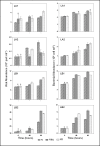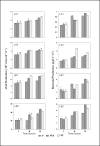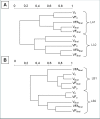Effect of grazers and viruses on bacterial community structure and production in two contrasting trophic lakes
- PMID: 21527043
- PMCID: PMC3114703
- DOI: 10.1186/1471-2180-11-88
Effect of grazers and viruses on bacterial community structure and production in two contrasting trophic lakes
Abstract
Background: Over the last 30 years, extensive studies have revealed the crucial roles played by microbes in aquatic ecosystems. It has been shown that bacteria, viruses and protozoan grazers are dominant in terms of abundance and biomass. The frequent interactions between these microbiological compartments are responsible for strong trophic links from dissolved organic matter to higher trophic levels, via heterotrophic bacteria, which form the basis for the important biogeochemical roles of microbial food webs in aquatic ecosystems. To gain a better understanding of the interactions between bacteria, viruses and flagellates in lacustrine ecosystems, we investigated the effect of protistan bacterivory on bacterial abundance, production and structure [determined by 16S rRNA PCR-DGGE], and viral abundance and activity of two lakes of contrasting trophic status. Four experiments were conducted in the oligotrophic Lake Annecy and the mesotrophic Lake Bourget over two seasons (early spring vs. summer) using a fractionation approach. In situ dark vs. light incubations were performed to consider the effects of the different treatments in the presence and absence of phototrophic activity.
Results: The presence of grazers (i.e. <5-μm small eukaryotes) affected viral production positively in all experiments, and the stimulation of viral production (compared to the treatment with no eukaryotic predators) was more variable between lakes than between seasons, with the highest value having been recorded in the mesotrophic lake (+30%). Viral lysis and grazing activities acted additively to sustain high bacterial production in all experiments. Nevertheless, the stimulation of bacterial production was more variable between seasons than between lakes, with the highest values obtained in summer (+33.5% and +37.5% in Lakes Bourget and Annecy, respectively). The presence of both predators (nanoflagellates and viruses) did not seem to have a clear influence upon bacterial community structure according to the four experiments.
Conclusions: Our results highlight the importance of a synergistic effect, i.e. the positive influence of grazers on viral activities in sustaining (directly and indirectly) bacterial production and affecting composition, in both oligotrophic and mesotrophic lakes.
Figures





Similar articles
-
Bottom-up versus top-down control of hypo- and epilimnion free-living bacterial community structures in two neighboring freshwater lakes.Appl Environ Microbiol. 2011 Jun;77(11):3591-9. doi: 10.1128/AEM.02739-10. Epub 2011 Apr 8. Appl Environ Microbiol. 2011. PMID: 21478309 Free PMC article.
-
Viruses and flagellates sustain apparent richness and reduce biomass accumulation of bacterioplankton in coastal marine waters.Environ Microbiol. 2007 Dec;9(12):3008-18. doi: 10.1111/j.1462-2920.2007.01410.x. Environ Microbiol. 2007. PMID: 17991029
-
Microbial community structure and dynamics in the largest natural French lake (Lake Bourget).Microb Ecol. 2006 Jul;52(1):72-89. doi: 10.1007/s00248-004-0230-4. Epub 2006 May 29. Microb Ecol. 2006. PMID: 16733620
-
A guide to the natural history of freshwater lake bacteria.Microbiol Mol Biol Rev. 2011 Mar;75(1):14-49. doi: 10.1128/MMBR.00028-10. Microbiol Mol Biol Rev. 2011. PMID: 21372319 Free PMC article. Review.
-
Fate of heterotrophic microbes in pelagic habitats: focus on populations.Microbiol Mol Biol Rev. 2005 Sep;69(3):440-61. doi: 10.1128/MMBR.69.3.440-461.2005. Microbiol Mol Biol Rev. 2005. PMID: 16148306 Free PMC article. Review.
Cited by
-
Diversity, Dynamics, and Distribution of Bdellovibrio and Like Organisms in Perialpine Lakes.Appl Environ Microbiol. 2019 Mar 6;85(6):e02494-18. doi: 10.1128/AEM.02494-18. Print 2019 Mar 15. Appl Environ Microbiol. 2019. PMID: 30635378 Free PMC article.
-
Viral-Mediated Microbe Mortality Modulated by Ocean Acidification and Eutrophication: Consequences for the Carbon Fluxes Through the Microbial Food Web.Front Microbiol. 2021 Apr 14;12:635821. doi: 10.3389/fmicb.2021.635821. eCollection 2021. Front Microbiol. 2021. PMID: 33935996 Free PMC article.
-
Two Predators, One Prey - the Interaction Between Bacteriophage, Bacterivorous Ciliates, and Escherichia coli.Microb Ecol. 2023 Oct;86(3):1620-1631. doi: 10.1007/s00248-022-02163-w. Epub 2023 Feb 1. Microb Ecol. 2023. PMID: 36723682
-
The Effect of Protozoa Indigenous to Lakewater and Wastewater on Decay of Fecal Indicator Bacteria and Coliphage.Pathogens. 2023 Feb 25;12(3):378. doi: 10.3390/pathogens12030378. Pathogens. 2023. PMID: 36986300 Free PMC article.
-
Effects of Ocean Acidification on Resident and Active Microbial Communities of Stylophora pistillata.Front Microbiol. 2021 Nov 25;12:707674. doi: 10.3389/fmicb.2021.707674. eCollection 2021. Front Microbiol. 2021. PMID: 34899619 Free PMC article.
References
-
- Sanders RW, Porter KG, Bennett SJ, DeBiase AE. Seasonal patterns of bacterivory by flagellates, ciliates, rotifers and cladocerans in a freshwater planktonic community. Limnol Oceanogr. 1989;34:673–687. doi: 10.4319/lo.1989.34.4.0673. - DOI
-
- Pomeroy LR. The ocean's food web, a changing paradigm. BioSci. 1974;9:499–504.
-
- Pace ML, McManus GB, Findlay SE. Planktonic community structure determines the fate of bacterial production in temperate lake. Limnol Oceanogr. 1990;35:795–808. doi: 10.4319/lo.1990.35.4.0795. - DOI
Publication types
MeSH terms
Substances
LinkOut - more resources
Full Text Sources

